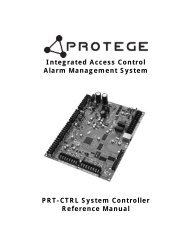SecureStream IP Receiver - Security Help Desk
SecureStream IP Receiver - Security Help Desk
SecureStream IP Receiver - Security Help Desk
Create successful ePaper yourself
Turn your PDF publications into a flip-book with our unique Google optimized e-Paper software.
Uploading and downloading data<br />
Downloading and uploading are terms for sending data to and from Challenger panels.<br />
<strong>SecureStream</strong> <strong>IP</strong> allows some data in the panel editor fields to be downloaded to, or uploaded from a<br />
panel — but this depends on whether management software is present:<br />
• When management software is present, then only uploading from a panel to <strong>SecureStream</strong> <strong>IP</strong> is<br />
possible (uploading requires the encryption key details to match at both ends). Downloading data<br />
to a panel in not possible.<br />
• When management software is not present, then both uploading and downloading are possible<br />
(uploading requires the encryption key details to match at both ends).<br />
Working with multiple <strong>SecureStream</strong> <strong>IP</strong> <strong>Receiver</strong>s<br />
Each Challenger panel can send <strong>IP</strong> event traffic to up to three <strong>SecureStream</strong> <strong>IP</strong> <strong>Receiver</strong>s, designated<br />
as main, backup, and disaster roles.<br />
The reason we refer to a Challenger panel and ‘its’ main <strong>SecureStream</strong> <strong>IP</strong> <strong>Receiver</strong> or ‘its’ backup<br />
<strong>SecureStream</strong> <strong>IP</strong> <strong>Receiver</strong> is that there can be several <strong>SecureStream</strong> <strong>IP</strong> <strong>Receiver</strong>s on a network, and<br />
any <strong>SecureStream</strong> <strong>IP</strong> <strong>Receiver</strong> can fill one of the three possible roles for any Challenger panel.<br />
One <strong>SecureStream</strong> <strong>IP</strong> <strong>Receiver</strong> is not necessarily designated as the main <strong>SecureStream</strong> <strong>IP</strong> <strong>Receiver</strong><br />
for an entire Challenger network, because a particular <strong>SecureStream</strong> <strong>IP</strong> <strong>Receiver</strong> can simultaneously<br />
be the main <strong>SecureStream</strong> <strong>IP</strong> <strong>Receiver</strong> for one or more Challenger panels, and the backup or disaster<br />
<strong>SecureStream</strong> <strong>IP</strong> <strong>Receiver</strong> for other Challenger panels in the same system.<br />
<strong>IP</strong> addresses of main, backup, and disaster <strong>SecureStream</strong> <strong>IP</strong> <strong>Receiver</strong>s are programmed via the<br />
management software or via the Challenger’s RAS keypad (not via <strong>SecureStream</strong> <strong>IP</strong>).<br />
Table 3 describes the main, backup, and disaster roles of <strong>SecureStream</strong> <strong>IP</strong> <strong>Receiver</strong>.<br />
Role<br />
Main<br />
Backup<br />
Disaster<br />
Function<br />
The Challenger will send all events to this <strong>SecureStream</strong> <strong>IP</strong> <strong>Receiver</strong> unless the<br />
<strong>SecureStream</strong> <strong>IP</strong> <strong>Receiver</strong> doesn’t acknowledge the receipt of an event.<br />
An event sent to a main <strong>SecureStream</strong> <strong>IP</strong> <strong>Receiver</strong> that isn’t acknowledged indicates<br />
to a Challenger that its main <strong>SecureStream</strong> <strong>IP</strong> <strong>Receiver</strong> is unavailable for some<br />
reason. After three retries the Challenger immediately reroutes all unacknowledged<br />
events and new events to its backup <strong>SecureStream</strong> <strong>IP</strong> <strong>Receiver</strong>, including a CID<br />
event code indicating that the main <strong>SecureStream</strong> <strong>IP</strong> <strong>Receiver</strong> is offline. Refer to<br />
Common Ademco CID error codes on page 57 for details.<br />
This is the <strong>SecureStream</strong> <strong>IP</strong> <strong>Receiver</strong> that the Challenger panel sends events to if its<br />
main <strong>SecureStream</strong> <strong>IP</strong> <strong>Receiver</strong> is unavailable. The Challenger will continue to send<br />
events to its backup <strong>SecureStream</strong> <strong>IP</strong> <strong>Receiver</strong> until its main <strong>SecureStream</strong> <strong>IP</strong><br />
<strong>Receiver</strong> sends a poll to the Challenger indicating it is online.<br />
If the Challenger’s backup <strong>SecureStream</strong> <strong>IP</strong> becomes unavailable, the Challenger<br />
immediately reroutes all unacknowledged events and new events to its Disaster<br />
<strong>SecureStream</strong> <strong>IP</strong>, including an event indicating its backup <strong>SecureStream</strong> <strong>IP</strong> is offline.<br />
This is the <strong>SecureStream</strong> <strong>IP</strong> that the Challenger panel sends events to if its main and<br />
backup <strong>SecureStream</strong> <strong>IP</strong> <strong>Receiver</strong>s are unavailable. The Challenger will continue to<br />
send events to its Disaster <strong>SecureStream</strong> <strong>IP</strong> <strong>Receiver</strong> until its main or backup<br />
<strong>SecureStream</strong> <strong>IP</strong> <strong>Receiver</strong> sends a poll to the Challenger to indicate the main or<br />
backup <strong>SecureStream</strong> <strong>IP</strong> <strong>Receiver</strong> is online. The main <strong>SecureStream</strong> <strong>IP</strong> <strong>Receiver</strong> is<br />
the preferred unit, and the Challenger will always send events to the main<br />
<strong>SecureStream</strong> <strong>IP</strong> <strong>Receiver</strong> if it is available.<br />
If the Disaster <strong>SecureStream</strong> <strong>IP</strong> <strong>Receiver</strong> becomes unavailable, the Challenger reroutes<br />
all unacknowledged events and new events to its dialler receiver, including<br />
an event indicating its Disaster <strong>SecureStream</strong> <strong>IP</strong> <strong>Receiver</strong> is offline.<br />
Table 3: Main, backup, and disaster roles of <strong>SecureStream</strong> <strong>IP</strong> <strong>Receiver</strong><br />
Main, backup, and disaster roles are configured in the Challenger Installer menu 47. Each<br />
<strong>SecureStream</strong> <strong>IP</strong> <strong>Receiver</strong>’s role is nominated by entering its <strong>IP</strong> address. See the previous section and<br />
the TS0898 Ethernet Interface Installation and Programming Guide for more details on programming<br />
the Challenger CID station via RAS.<br />
Example:<br />
CID station 1 <strong>IP</strong>: 201.107.008.025 = Main<br />
CID station 2 <strong>IP</strong>: 201.107.008.036 = Backup<br />
CID station 3 <strong>IP</strong>: 208.126.192.002 = Disaster<br />
10 <strong>SecureStream</strong> <strong>IP</strong> <strong>Receiver</strong> Installation & Programming Guide 2.0
















